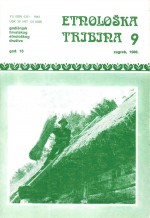Etnolkoreološka podoba Bele Krajine
Ethnochoreologic Outlook of Bela Krajina
Author(s): Mirko RamovšSubject(s): Theatre, Dance, Performing Arts, Customs / Folklore, Ethnohistory, Cultural Anthropology / Ethnology, 18th Century, 19th Century
Published by: Hrvatsko etnološko društvo
Keywords: Bela Krajina; ethnology; dance; choreology; folklore;
Summary/Abstract: The basic characteristic of dances in Bela Krajina is the stratified age of their elements, with regard to choreology, music and text. It is impossible to isolate the strata from one another because they are intertwined into a conglomerate where a single layer of cultural elements is difficult to discern. The odlest stratum is represented by dances which consist of walking in a dosed circle, and snake-like or snail-like lines, with the final promenade »under the bridge« of the lifted arms of two dancers. Dances which are akin to children’s games of Indoeuropean origin, but were danced by adults in Bela Krajina, also belong to this group. The second stratum of the dance tradition here is of Uskok origin: characteristic feature is dancing without instrumental accompaniment, that is, accompanied only by singing. The tradition of »mute« dancing has been preserved to this day only in the »pure Uskok« village Bojand. In the Poljanska valley, instrumental accompaniment has already been added. The third stratum is represented by dances of central European provenance (štajeriš, zibenšrit, šotiš and others) which came to Bela Krajina via Dolenjska in the 18th and 19th centuries. Dances of the most recent stratum come from the Croatian Pannonia: tamburitza-band musicians contributed to their spread at the end of the 19th century and in the first decades of this century. The establishment of amateur groups for the performance of folklore in Bela Krajina has stimulated the growth of folklorism: amateurs have endeavored to preserve local traditions, but in their effort to reach the »origins« they have frequently invented new dances or have borrowed from the repertoire of other folklore performing groups. The ethnochoreologic outlook of Bela Krajina thus affirms that the kolo dance was important primarily in regions with strong uskok tradition; otherwise, the dance tradition here is identical with those of other Slovene regions, but somewhat specific in form and nomenclature.
Journal: Etnološka tribina : Godišnjak Hrvatskog etnološkog društva
- Issue Year: 16/1986
- Issue No: 9
- Page Range: 149-156
- Page Count: 8
- Language: Slovenian

